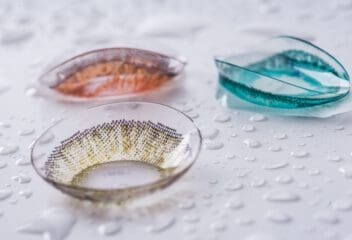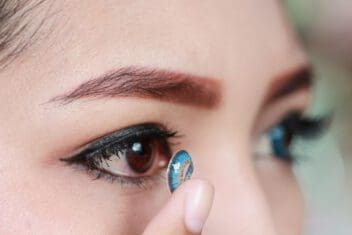Colored Contact Lenses: A Beginner’s Guide
Home / Understanding Contacts /
Last Updated:
Table of Contents
In the realm of personal expression and stylistic freedom, colored contacts are a remarkable tool that often flies under the radar. They are not only used to correct vision but also to redefine one’s aesthetic, whether it’s subtle enhancement or a dramatic transformation. If you’ve ever wanted to experiment with your look, or wondered what you would look like with a different eye color, colored contacts could be your answer.
Colored contact lenses are medical devices, just like their clear counterparts, but they have a layer of tint to change your eye color. They can serve a dual purpose: correcting your vision while allowing you to change the color of your iris. Alternatively, they can be purely cosmetic, meaning they have no vision-correcting prescription, used solely to alter your eye color.
You must have a prescription to obtain and use any type of colored contacts.
In the US, over 45 million people wear contact lenses to correct their vision, and many of them wear colored contacts.

Colored Contacts Basics
Colored contact lenses, like clear lenses, can be either prescription or plano (non-prescription). Prescription lenses correct refractive errors such as myopia (nearsightedness), hyperopia (farsightedness), and astigmatism, while plano lenses are for cosmetic purposes only.
Colored contacts can be designed to mimic the natural look of the iris, which is the colored part of the eye. This is achieved through a series of color dots on the lens surface, creating depth and giving the illusion of a realistic eye color.
You deserve clear vision. We can help.
With 135+ locations and over 2.5 million procedures performed, our board-certified eye surgeons deliver results you can trust.
Your journey to better vision starts here.
Regardless of the look you are going for, it is important to be fitted for colored or decorative contacts by an eye doctor. You can then receive a specialty prescription for these lenses.

Colored contact lenses are used for:
- Aesthetic purposes. They can alter eye color and look subtle, or the change can be more drastic. The choice is up to you, depending on how much of a difference and what kind of look you are going for. They can be used to make your eyes appear lighter, enhance their natural color, or change their color altogether.
- Correction. You can get customized colored contacts to alter the appearance of the eye if it has been injured or if you suffer from a congenital eye defect. These customized lenses can be designed to look like a healthy pupil, and colors can help to create a more natural look.
- Sports. Customized color contacts can also be used specifically for sports to improve vision under specific circumstances. These colored contacts often have a “sports tint” that can help to deflect glare, increase depth perception, and make contrast more defined.
- Special effects. There are contact lenses called “special effect contact lenses,” or novelty contacts, that can make your eyes appear cat-like or give you a vampire look.
Types of Colored Contacts
Both types of colored contacts require a prescription even if you don’t need prescription eyewear, as both are considered medical devices that are being put into your eyes. The FDA must approve all contacts and oversees these products to ensure they are safe.
Colored contacts come in different tints depending on the look you are going for. These include:
- Enhancement tint. These are great for light-colored eyes. An enhancement tint can bring out the natural color of your eyes and help to make them really pop. This is a see-through (translucent) tint that can make eye color more vibrant.
- Visibility tint. This type of tint is typically very minor and often does not change the color of your eyes. It is designed to make contacts easier to see and handle when putting them into your eyes.
- Opaque tint. These tints are not transparent and can completely alter your natural eye color. If you have dark eyes, you will need an opaque tint to change the color of your eyes. Opaque tints come in a wide range of color options. Special effect contact lenses are typically opaque tints as.
- Custom tints. You can get colored contacts specially made and customized to suit your specifications. If you are trying to change the look of your eyes due to a defect or injury, if you are an athlete and looking for a special sports-related tint, or if you just want something unique, you can obtain a custom tint.
Colored contacts, like traditional contacts, come in a variety of forms, including daily disposable, weekly use, or monthly use.
These brands make popular versions of colored contacts:
- Alcon: Their Air Optix colored lenses come in a variety of colors. They also make Dailies Colors, which offer daily contact lenses in a range of colors.
- Acuvue: Their Define colored contacts are very popular.
- FreshLook: Their Dimensions colored lenses are made specifically for lighter eyes. Their Colorblends lenses offer subtle results.
If you are only wanting to change your eye color sometimes and not every day, then daily disposable colored contact lenses can be a great idea. These lenses allow you to experiment with different eye colors and see if you like them without committing to them long-term.
Do You Really Need Prescriptions for Cosmetic-only Contacts?
By law, even if your colored contacts are for cosmetic purposes only, a prescription from an eye care professional is still crucial. It’s not just about vision correction – it’s primarily about your eye health and safety.
Getting a prescription for your colored contacts ensures you get a proper:
- Fit: Contacts are not one-size-fits-all. Your eye doctor measures your eyes to prescribe the proper fit, avoiding discomfort or eye damage.
- Health Assessment: An eye doctor evaluates if your eyes are suitable for wearing contacts, taking into account factors like dry eyes or allergies.
You deserve clear vision. We can help.
With 135+ locations and over 2.5 million procedures performed, our board-certified eye surgeons deliver results you can trust.
Your journey to better vision starts here.
Possible Risks of Colored Contact Lens
All contact lenses come with some measure of risk. Typically, if you follow all cleaning, wearing, and storing directions, you can minimize the potential risks.
Injuries and issues may be more common with colored contacts than regular contacts because many people purchase them from costume stores that are not authorized retailers. There is an increased risk if the lenses are not properly fitted to your eyes.
Infection in the eye is one of the biggest issues related to contact lens wear. Proper hygiene can help to decrease the odds of this.
Colored contacts will need to be fitted and prescribed to ensure proper fit. If contacts don’t fit correctly in your eyes, the following side effects are possible:
- Corneal abrasions or scratches
- Infection of the cornea and possible ulcerations
- Decreased vision
- Allergic reactions
- Conjunctivitis (pink eye)
- Blindness
Vision can sometimes be impaired by colored contacts. The size of your pupil can change throughout the day and in different lighting conditions. The clear part of the colored contact may not be exact, and if your pupils enlarge beyond it, this can decrease vision.
Colored contacts can also slide around at times. This can make it clear that the color is not natural.
Colored contacts obtained through a valid prescription and taken care of properly are typically considered safe to wear. However, they are still not without risk. If your eyes get irritated from wearing colored contacts, take them out and talk to your doctor.
Colored Lens Safety
It is vital to obtain a prescription for any kind of contacts, even those only worn for cosmetic reasons. They will need to be fitted specifically to your eyes.
Even if you don’t need your vision corrected with prescription contacts or eyeglasses, you will need to get a special prescription from an eye doctor in order to use colored contacts. These are still medical devices that are going to be placed into your eyes. It is important to make sure they are comfortable and will fit your eyes specifically.
Only buy colored contacts from an FDA-approved retailer. Do not buy them from a street or fair vendor, a beauty salon, a novelty store, or an internet retailer that does not ask for a prescription. Anyone selling colored contacts that does not ask for a prescription is doing so illegally, and these lenses may not be safe to wear.
In order to avoid possible complications, an optometrist will need to ensure that the prescription and sizing of colored contacts are right for you. To help make sure you keep your eyes safe when wearing colored contacts, follow these tips:
- Follow all directions regarding your color contacts. Use them on the specific wear schedule and replace them as directed. If they are daily disposable lenses, for example, be sure to take them out each night and replace them with new ones each morning.
- Only use the contact solution designed for your lenses. Store them as recommended by the manufacturer.
- Discuss your options for colored contacts with your optometrist. Only wear lenses that are prescribed for you directly.
Colored contacts can be a fun way to change up your look. They can be safe when used exactly as prescribed.
You deserve clear vision. We can help.
With 135+ locations and over 2.5 million procedures performed, our board-certified eye surgeons deliver results you can trust.
Your journey to better vision starts here.
References
- ‘Colored’ and Decorative Contact Lenses: A Prescription is a Must. (February 2016). U.S. Food and Drug Administration (FDA).
- Decorative Contact Lenses. (September 2018). U.S. Food and Drug Administration (FDA).
- Are Costume Contact Lenses Safe? (September 2020). American Academy of Ophthalmology.
This content is for informational purposes only. It may have been reviewed by a licensed physician, but is not intended to serve as a substitute for professional medical advice. Always consult your healthcare provider with any health concerns. For more, read our Privacy Policy and Editorial Policy.
